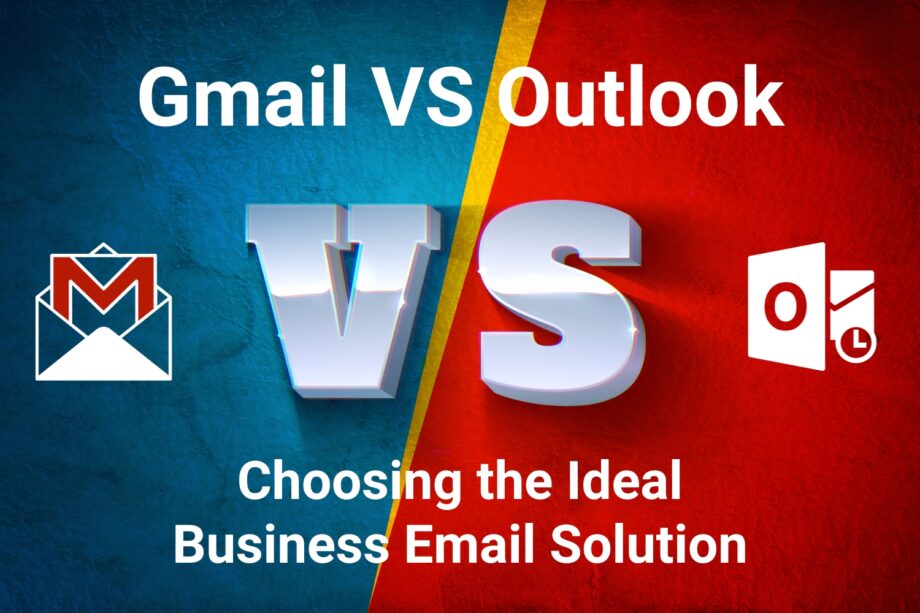In the realm of business communication, selecting the right email solution is paramount. It’s a choice that can significantly impact productivity, collaboration, and the overall success of your organization. Two giants dominate this landscape: Gmail and Outlook. The “Gmail VS Outlook” debate has raged on for years, with each platform boasting its own set of strengths and features. If you find yourself at the crossroads, trying to determine the ideal business email solution for your company, this article will serve as your guiding compass. We’ll explore the key differences, advantages, and considerations when choosing between Gmail and Outlook, helping you make an informed decision tailored to your specific needs and preferences.
How do Gmail VS Outlook compare?
Gmail and Out look are both formidable email clients tailored for business use, but they exhibit notable distinctions in various aspects:
User Interface and User Experience:
Gmail vs Outlook user interface is structured gthree main panels: the navigation pane, content pane, and preview pane. The navigation pane, situated on the left, houses email folders like the inbox, sent items, drafts, and deleted items. In the middle content pane, users can view emails with essential details such as sender, subject, and date. The preview pane, on the right, permits users to quickly peruse email content without loading a new page.
Outlook also features ribbon tabs packed with numerous options and commands, including composing new emails, text formatting, inbox filtering, and configuring automatic replies. Additionally, a handy navigation bar provides swift access to the calendar, tasks, contacts, and notes.
In contrast, Gmail opts for a more minimalist approach in its user interface. It lacks a ribbon tab and adopts a single-panel layout. Gmail displays the inbox in a standard list format, with email folders listed on the left. To view emails in Gmail, users must click on each one individually, leading to the loading of a new page. This can be less convenient for users dealing with a large volume of emails.
Composing emails in Gmail, however, is straightforward. Clicking the compose button opens a small window at the bottom of the page containing all necessary formatting tools and email options. Gmail offers a navigation bar for quick switching between mail, group chats, and video calls, but calendar functions are available through a separate app.
Inbox Management:
In terms of inbox management, both email clients provide tools for sorting and organizing emails. Outlook empowers users to create folders and subfolders for manual email categorization. Additionally, it offers rules and filters to automatically sort incoming messages based on sender or specific keywords in the subject line, directing them to designated folders.
Outlook elevates inbox management further with its “focused inbox” feature. This feature instantly segregates essential emails from less important ones. Emails marked as important by users are automatically directed to the focused inbox, while all other messages are placed in the “other” folder. Users have the flexibility to customize the focused inbox by designating specific senders or subjects as high or low priority.
These distinctions in user interface and inbox management play a significant role in determining which email client aligns better with individual preferences and business needs. While Outlook offers a more robust and multifaceted interface, Gmail follows a more streamlined approach with a focus on simplicity. The choice between the two depends on users’ priorities and their inclination toward a feature-rich experience or minimalistic design.
Gmail vs Outlook: Let’s go through the points of choosing the ideal business email solution
Explain Bellow:
User-Friendliness and Functionality:
Gmail VS Outlook, provided by Google and Microsoft respectively, are renowned for their exceptional email services, app integrations, and customer support. However, they differ significantly in terms of user-friendliness and functionality.
To make an informed decision, begin by listing your business priorities. Then, evaluate each platform’s features and capabilities to align with your specific requirements. It may require some trade-offs, as one may excel in areas where the other falls short.
Gmail offers an easy-to-navigate user interface, making it ideal for personal use. In contrast, Outlook provides a wealth of functionality but may appear more complex. The key distinction lies in storage capacity and the array of features they offer.
Outlook is highly adaptable and customizable, making it the top choice for handling a large volume of emails effectively. In contrast, Gmail caters more to individuals and small businesses, providing simplicity and ease of use.
Organizational Capabilities:
Outlook’s strength lies in its traditional folder system, which is user-friendly for newcomers. On the other hand, Gmail offers a more intuitive categorization system. Gmail users can place emails into specific categories and mark them as important or unimportant, streamlining their organization. However, Gmail displays conversation messages in a single line, while Outlook presents them in two.
Security:
Security is paramount in business email solutions, and both Outlook and Gmail offer robust tools to ensure protection. Both services encrypt messages during transit and utilize the Exchange Online Protection service for email safety. Additionally, they provide account usage history and spam filters. Outlook users benefit from an extensive range of security tools.
While both services offer password protection and two-factor authentication, Gmail takes security a step further compared to Yahoo Mail. Users can conveniently access email and other features through the desktop edition of Outlook. Outlook offers customization options, such as theme and inbox modifications, though not as extensive as Gmail’s.
Outlook is known for its transparent privacy policy and offers a wider range of third-party application integrations. In contrast, Gmail, without a built-in calendar or contacts feature, seamlessly syncs with third-party calendars and workspaces. For those undecided between the two solutions, exploring third-party applications is a viable option.
User Interface Comparison:
Gmail boasts a user-friendly interface that utilizes categories and labels for organization. Users can designate emails as important or unimportant while benefiting from spam protection. Gmail simplifies email management by displaying conversation messages in a single line.
Outlook’s user interface may appear more intricate to new users, but it matches Gmail’s security standards. Outlook employs a file-based structure and introduces the email flagging feature, allowing users to label emails as spam or harmful. These flagged emails stand out in the inbox.
Malware Protection:
Both Google and Microsoft prioritize malware protection, deploying automated and manual scanners to detect harmful websites in their search indexes. This proactive approach safeguards users from potential threats. However, Microsoft has had its share of security challenges, including vulnerabilities in their Exchange Server and Outlook email apps. Microsoft Defender, their security tool, can sometimes be overly aggressive, blocking legitimate messages.
If you seek to purchase Gmail or Outlook accounts for your business, Bulk Account Sale offers 100% secure and active accounts to meet your requirements. Make your choice wisely based on your business’s unique needs and priorities.
Conclusion:
In conclusion, the choice between Gmail vs Outlook hinges on your business’s specific needs. Gmail excels for personal use and small businesses that prioritize simplicity and efficiency. In contrast, Outlook is the preferred choice for larger enterprises requiring extensive storage, advanced features, and robust organization capabilities. When considering privacy and security, both services provide solid protection, but Outlook offers a more transparent privacy policy and broader third-party integrations.




